8
THE METROPOLITAN DELTA
JONESBORO, PARAGOULD AND POINTS BEYOND
Jonesboro feels like a town out of its natural habitat. It doesn’t feel like what the rest of the state feels like. That was one of the first thoughts I had about the place when I moved there in 1995. Over the three years I roamed the town and its surroundings, I never quite lost that feeling.
The town is one of two county seats in Craighead County—a county, I have to tell you, that was named out of spite. In 1858, Senator William Jones proposed carving the county out of land represented by fellow state senator Thomas Craighead, who thought the idea was asinine. The bill passed anyway, and when it did, Jones proposed that it be named for Craighead, who in turn proposed that the county seat be named for Jones. The town of “Jonesborough” was created. The name was simplified to Jonesboro before its official incorporation one-quarter century later.
The city flourished at the end of the nineteenth century thanks to timber rail lines, most notably with operators like Missouri Pacific, Frisco and Burlington Northern Santa Fe serving the area. The establishment of City Water and Light (CWL) in 1906 helped the city flourish, and even today, CWL keeps rates in town remarkably low. In 1910, the First District Agricultural School offered its first courses; this facility would eventually become Arkansas State University.
Jonesboro was home to the first woman to serve in the United States Senate, Hattie Caraway, who succeeded her husband after his death in 1932. It’s also home to Olympic pole-vaulter Earl Bell and Miss America Debbye Turner and was the birthplace of noted novelist John Grisham.
In my mind, Jonesboro isn’t a typical Arkansas town. The largest city on the east side of the state is the home of a burgeoning student population that brings new ideals to the area with each incoming class. It’s a manufacturing and food production hub for gigantic operations such as Post and Frito Lay. It’s a medical magnet with a couple huge hospitals treating what ails citizens of the Delta, and it’s an agricultural crossroads that takes in the bounty of farmed produce and grain and returns it in packaged goods.
If Jonesboro was a person, it’d be a guy in a blue button-down shirt and overalls.
In the latter half of the 1990s, it was packed full of homegrown restaurants of every variety, including a heavy smattering of Asian offerings. Gee Street on the west side of town was home to a collection of cheap diners, drive-ins and ice cream joints. South Caraway had all the sit-down places. North Caraway catered to the college crowd, and way out in Nettleton there were great catfish and barbecue joints. There was always something neat and new to try in the town.
The old roots were strong. No one could remember quite how long Wyatt’s Cafeteria had been in Indian Mall, or if there was a thrown-roll place before the Front Page Café. Places like Jason’s Dairy Breeze and Frank’s Eskimo Queen were frequented just the way they had been done a generation past, and the Galley still served big fat hush puppies.
When I started writing this book series, I was thrilled to be sharing more about this strange metropolitan place in the Delta. I had a score of restaurants to share, including five very old Chinese restaurants that I thought might seed more research on restaurants of that ilk through the Delta. I was heartened by a possible connection between these places and the Chinese-owned grocery stores researched in both Arkansas and Mississippi by the folks over at the Southern Foodways Alliance. Imagine my shock when I arrived in Jonesboro for a weekend of research in March of 2014 and found that every one of them was gone—every single one.
But it wasn’t just the Asian restaurants. Jason’s, Frank’s, even the old standard of Couch’s Corner Barbecue had met their end, mostly in the three years preceding my visit. In their place was a score of new enterprises. Mind you, some of them (especially the ones now crowding Jonesboro’s Main Street downtown) are very welcome; Godsey’s Grill, Skinny J’s, Omar’s Uptown and Cregeen’s Irish Pub are all locally owned mid-range restaurants that have given downtown the revival it so desperately needed. But the big chains came in with the loosening of liquor laws that allowed “private members” to purchase drinks with dinner, and places like Red Lobster, Applebee’s, Buffalo Wild Wings and Olive Garden quickly choked out the homegrown restaurants.
It’s stunning, what has happened. The town has long been known for having fantastic cheap eats, but they’ve evaporated. The price point has gone up, and the little operations have struggled. In the end, just a handful of the local restaurants have hung on to become classics.
There is irony in the fact that the big chains aren’t doing so well in Jonesboro. There’s another comparison to be made, too, just up the road in Paragould—a city half the size but better equipped to support its classics. In this city, you’ll find the second-oldest bakery in the Delta, along with a holdout from the long-gone Dog n Suds chain and one of the most stunning gutbomb burgers you may ever encounter. Paragould keeps the Couch’s name alive with its Couch’s Bar-B-Q, run by another offshoot of the famed barbecue family.
The story of metropolitan classic dining in the Delta is truly a tale of two cities.
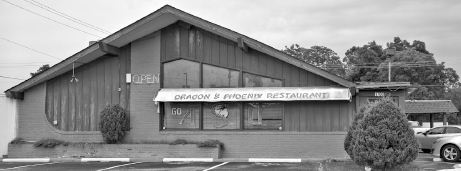
Jonesboro at one time was home to many Chinese restaurants. In 1996, those restaurants included Beijing Chinese Restaurant, Dragon City, Dragon & Phoenix, Great Wall of China, Hunan China, China Garden, Imperial Chinese, Kowloon and China Kitchen. Dragon and Phoenix was the last of Jonesboro’s classic Chinese restaurants to close. Grav Weldon.
PARAGOULD
Paragould was built around rails and lumber. In 1872, the St. Louis and Iron Mountain Railroad began service through Arkansas between St. Louis, Missouri, and Texarkana. James W. Paramore, president of the Cotton Belt Railroad, wanted a way to ship Texas cotton to St. Louis and points beyond. In 1877, he made a deal to connect his Texas railroad line with the Iron Mountain in Texarkana. About that time, the Palmer and Sullivan railroad system was being developed in Mexico. Paramore’s directors voted to expand their Texas railroad line to join the Mexican railway, giving St. Louis a direct connection through Arkansas and Texas to Mexico City.
Jay Gould, who gained control of the Iron Mountain Railroad in 1880, learned that Paramore’s Texas—St. Louis Railroad was licensed to build a cheaper narrow-gauge line through Arkansas to Texas. Gould constructed a regular-gauge line to parallel Paramore’s route that ran through Greene County toward Helena. Where they crossed, a community called Parmley popped up. However, postmaster Marcus Meriweather decided to name the town on his own volition—Para for Paramore and Gould for Gould. Thus in 1883, Paragould was born.
Weird things happening are a part of Paragould’s history. In 1930, a meteorite streaked across the sky and came down four miles away in the Finch community; it weighed all of seventy-five pounds. In 1936, Frank Reynolds and Lloyd Rogers discovered large bones in a creek that turned out to be a ten-thousand-year-old mastodon.
BATTEN’S BAKERY, PARAGOULD
Batten’s Bakery may have one of the strangest lineages of any Delta restaurant I know. See, Mike Batten is a Batten who owns Batten’s Bakery in Paragould, but he may not be the Batten you are looking for. In fact, though Batten’s Bakery has been around since 1954, I don’t believe Mike has been around that long. And besides, Albert Batten wouldn’t have had a clue who he was.
That doesn’t change the power of the name of the oldest bakery in northeast Arkansas, nor does it invalidate the family’s connection to pastry-making. Confused? Let me enlighten you.
Albert Batten started making doughnuts in a garage at Thompson and South Fifth Streets. It wasn’t much of an operation at first, but it became a community staple. Batten would get up early in the morning and make doughnuts and sell them until they were gone. Customers say he didn’t believe in day-olds, so if a regular came into the kitchen garage late in the day, he was apt to throw a few extra in to make sure they got gone. They were a bargain, too, at fifty cents a dozen. Over the years, the offerings expanded to cakes, pastries and such. A few individuals even claim that Elvis Presley was once spotted there downing a bearclaw—though the veracity of such a statement is doubtable.
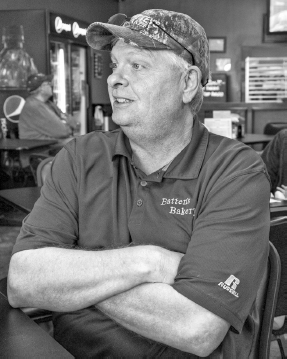
Mike Batten is the latest Batten to run Batten’s Bakery in Paragould. Grav Weldon.
Eventually the little garage kitchen became too small for the operation, so in 1965 Batten moved out and east one-half mile on Kingshighway to a spot that sat catty-corner to Dog n Suds (still in operation today). While still small, a few people could come in and have breakfast in the little eatery. Batten also made doughnuts for local grocery stores to sell, and his golden rings became the standard for the area.
Batten kept the bakery going for decades, but when his health waned, he was ready to pass it on. In 1980, he sold it to Bonnie Abbott, who had worked there since she was a young woman and who reportedly never worked at another establishment. In the 2000s, Leon Johnson bought the place and ran it for four years, through one of the worst financial times for bakeries anywhere, with the rise in prices of eggs, milk and flour.
Enter Mike and Bridgette Batten. The couple worked in the corporate world—he was a design engineer, she was a director of systems management—but while in the area in 2004 they happened to learn that the bakery was available. It seemed like providence, so soon the younger Battens had themselves a bakery. They’ve managed to collect many of the recipes used by both Albert Batten and by Bonnie Abbott, and they turn out a goodly number of baked goods six days a week for the citizens of Paragould.
As I mentioned in Arkansas Pie: A Delicious Slice of the Natural State, Batten’s Bakery offers a rare traditional pie that is available nowhere else—a chocolate old-fashioned that’s filled with cocoa, butter and sugar, not custard and certainly not pudding. The flavor of this pie, its flaky consistency and its density all remind me of the good things about growing up in Arkansas. It’s certainly a pie a grandmother would have conjured.
DOG N SUDS, PARAGOULD
Dog n Suds isn’t an Arkansas original by any means. The original restaurant was opened in Champaign, Illinois, in 1953 by Don Hamacher and Jim Griggs, two music teachers who just wanted to offer a place for kids to get hot dogs and root beer. The first Dog n Suds was so popular that a wealthy dowager paid them to build her another one, and soon Don and Jim were done with teaching music for a living and hot on the path of creating a franchise. Locations quickly spread, first throughout Illinois and Indiana and then into Ohio, Michigan and the rest of the United States. By 1970, there were six hundred Dog n Suds in thirty-eight states and Canada, and the eatery’s popular creamy root beer had become well-known and well-liked.
In the 1970s, Dog n Suds merged with another restaurant chain, and the management at that chain eliminated the original formula root beer and replaced it. Original location owners started to break away, while others closed. The final insult came when the East Coast company that had taken on Dog n Suds sold the rights to the root beer recipe to a bottler in Michigan.
Those few locations that kept the original root beer and look of the drive-in manage to not only stay afloat but also to thrive. Many have incorporated under a new set of owners, Don and Carol VanDame, who purchased the rights and trademark in 1991. Their new company, TK&C’s LLC, incorporated in 2001, has licensed the Dog n Suds brand.
Today, there are fourteen Dog n Suds locations left, the southernmost of which is in Paragould. It’s one of the few locations with the original sign plus the ice cream cone—absent on most of the rest (see it on the front cover of this book). A mug of frosty, creamy root beer is $1.30, while you can take home a gallon for $4.50. Chili dogs and footlong hot dogs are still popular, but the menu has been expanded to include hamburgers, chicken strips, salads and even burritos. It’s open six days a week, and from time to time you’ll find someone who’s made the pilgrimage to sit in their car and revel in this remaining slice of nostalgia.
PARAGOULD’S CLASSICS
Paragould residents have been able to get a Mexican restaurant fix for cheap since 1975, thanks to Taco Rio. It looks like it might be a chain operation, but it’s actually a locally owned and operated Tex-Mex joint with very cheap prices. Tacos, burritos, enchiladas and nachos—this is the place in town to get your fix.

Orders coming out at Taco Rio in Paragould. Grav Weldon.
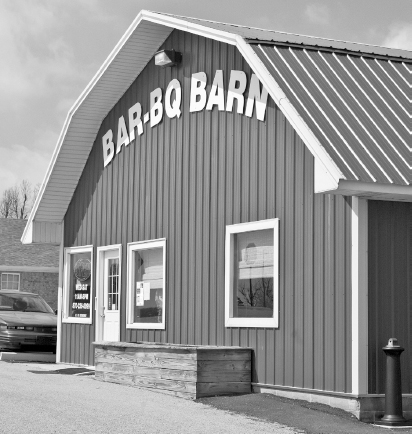
The Bar-B-Q Barn in Paragould is known both for great ribs and crispy catfish fillets. Grav Weldon.
Taco Rio is best known not for a taco but for a burger—one made from taco meat. In fact, the only difference between the taco burger and a taco is the bun in place of the shell. They’re pretty good, but the real delight is having one covered in either chili or cheese dip.
The town is full of great places for cheap eats. Terry’s Café downtown is one of those excellent little breakfast-and-lunch diners that always has whatever home cooking item you’re really craving. BBQ Barn on the west side of town has marvelous barbecue and smoked chicken and some of the most notable catfish in town.
And then there’s Hamburger Station. Situated in an old tile-topped Texaco station alongside the railroad tracks north of downtown (seen on this book’s cover); the little eatery has a big following. The star of the show is the Humburger—an old-fashioned, fat sashy served with onions and mustard on a toasted bun. These little gutbombs have become notorious, adored by blue-collar workers and motorcyclists alike.
BARBECUE IN THE METROPOLITAN DELTA
I mentioned Couch’s Bar-B-Que at the start of this chapter. During my KAIT days, Couch’s was famous. It was the barbecue around town. Heading out to the east side of town for ribs was a thing back then.
Couch’s Corner Bar-B-Q in Jonesboro had a good run, more than forty years of great smoked meats dating back to 1970. It went under a few years ago, but the family continues the tradition at two other locations. Couch’s Bar-B-Que in Paragould is an important stop for any food lover. It’s not just a great place to grab a pulled pork sandwich or a hearty breakfast, it’s a time capsule for the Greene County town. The oversized restaurant is often full, and on its walls you’ll find images from Paragould’s earliest days.
The other location is Couch’s Log Cabin Bar-B-Q. Run by Steve Horne, this location southeast of Jonesboro has been going strong since 1984.
Fortunately for Jonesboro residents, there’s still good barbecue to be found at another classic: Demo’s Smokehouse. The barn-style restaurant smells like a good July afternoon outdoors—lots of sweet smoke and wood. It’s the place in the area for true St.Louis–style ribs, and the smoked chickens are excellent. Demo’s does a lot of catering around the area these days, and its sweet peppery main sauce is divine.
GINA’S PLACE, JONESBORO
One of the best local lunch spots is out of sight of the roadway. Gina’s Place is tucked into the far side of Fountain Square off Highland, and it’s been offering amazing sandwiches and plate lunches since 1983. Many call it by its previous name, Ann’s.

A slice of peanut butter pie at Gina’s Place in Jonesboro. Kat Robinson.
Ann Maynard and Glen McKay started the restaurant up some thirty years ago. Their daughter Gina worked there through high school but left to go to business school and start her career. Jonesboro eventually pulled her back, and she returned to the restaurant. When her mom decided to retire in September 1997, Gina and her brother, Vernon, suggested they buy the place and take it over, but Ann said no. She didn’t want them to go through the strife of running the restaurant.
The restaurant had a buyer, and Ann walked away, but that buyer came back a month later and said it wasn’t going to work. Gina and Vernon McKay bought it and took it over immediately.
Vernon eventually left, but Gina is still making it work. A few years ago, she decided it was about time the restaurant bore her name, and so Ann’s Restaurant became Gina’s Place. Not much else has changed. Baked pork chops are offered every Wednesday, coconut cream pie on Thursday and salmon patties on Friday. A second generation of families now comes in for a bite on a regular basis.
The secret item for breakfast lovers is, I kid you not, called Garbage: two eggs, hashbrowns, onions, peppers, tomato, jalapeños, cheese and a choice of meat all grilled up together. A hot mess, but a good one.
Salmon Patties
1 16-ounce can or sealed package salmon
2 large eggs, beaten
1 small onion, finely grated
2 tablespoons fresh parsley, minced
Ground black pepper, to taste
1–1½ cups fine, dry breadcrumbs
3 tablespoons butter
Flake salmon with a fork. Beat together grated onion, parsley and pepper. Mix with salmon. Add enough bread crumbs, about ½ to ¾ cup, to make thick enough to shape into 12 small patties. Roll patties in ½ cup bread crumbs. In a large heavy skillet, over low heat, melt 2 tablespoons of butter; add patties. Fry patties slowly on one side; add remaining butter, turn patties and fry until brown on the other side. Serves 6.
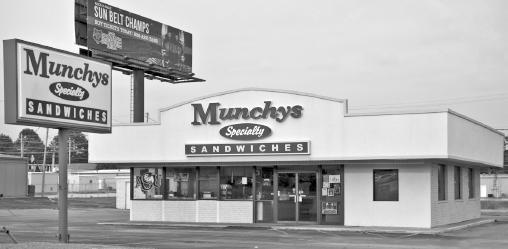
Munchy’s Specialty Sandwiches in Jonesboro. Grav Weldon.
MUNCHY’S SPECIALTY SANDWICHES, JONESBORO
Every college town has a local college eatery. For Jonesboro, it’s Munchy’s Specialty Sandwiches. Though a small chain was attempted decades ago, this original, slightly expanded shop is all that remains, serving sandwiches for a pretty low price to hungry college students and town residents.
Munchy’s offers pretty traditional sandwiches. There is one called the BBQ & You that’s barbecue sauce over roast beef, and there’s Roger’s Delight, which features roast beef, turkey, American and Monterrey jack cheeses dressed with lettuce, tomato and onion. One thing’s for certain—if you’re a Red Wolf (or, for older Arkansas State University alumni, Indian), this is a haven for nostalgia.
PRESLEY’S DRIVE IN, JONESBORO
In a different time, Presley’s Drive In was a place of summer. Started by Harold and Hettie Mae Presley back in the early 1970s, it passed first to their son Terry Presley and then to Gary McGill. It’s a fine dairy diner that has now served western Jonesboro for more than forty years. The décor has always been simple dairy diner, with a nod to a distant relative born in Tupelo.
My boyfriend and I lived a half mile west of Gee Street in the late 1990s, and we’d gather up laundry twice a month and head over to the Magic Touch for a laundry derby. Once the first round of loads were in on a Monday afternoon, I’d walk over to Presley’s and pick up brown derbies for us both.
Gee Street was much different then. All sorts of restaurants lined the streets, like the Milky Way Drive In and Grandpa’s, along with the old grocery store, flea markets and low-rent motels. In the summer, it was whitewashed and ancient and out of time.
When Grav and I went back to see Presley’s in March 2014, we found nothing the same on Gee Street. The grocery store that still took stamps was now a Hays Supermarket, and the little diners and lunch counters were, all of them, absorbed into the past—except Presley’s, which was almost untouched. There it stood, recently painted, depictions of menu items painted on the windows and a full house of customers. I wanted a brown derby, but I was denied. On this particular visit, the ice cream machine was out.
It made no difference. While Grav scarfed his half of a particularly excellent Reuben sandwich, lovingly butter-toasted on both sides, I picked at my offered Oreo cake (light and fluffy!) and at my memories, too—of those laundry days, of very hot summer days when I decided like a fool to take the dog for a walk, puffing the breath out of my lungs while standing at the outside counter with Jeffro, my Great Dane. Not only would I get my burger and fries and a big vanilla Coke, but they’d always offer Jeffro a vanilla cone, and it’d be gone in a swallow.
It’s hard to believe that more than fifteen years have passed since I moved away, and yet this place is still here. That’s partly thanks to David Stallings, who purchased the restaurant back in October 2012, not long after Gary’s health got a little touchy. The menu hasn’t changed a whole lot—there are still burgers, fries, shakes and the like, and breakfast and good plate lunches, too.
In fact, many of those more unusual dishes remain on the menu, like the Pizza Steak (a traditional Arkansas Delta pizza burger) and the Spanish Burger (with taco sauce). Other dishes could have been taken straight out of my Tie Dye Travel adventures—like the fried cheeseburger and the grilled cheese cheeseburger (the Excaliburger from the Ozark Café, seen on the back of Classic Eateries of the Ozarks and Arkansas River Valley).
There’s something new that’s recently shown up on the restaurant’s Facebook page. Presley’s now offers a competition burger called the King. It’s seven pounds—four pounds of beef, a pound of bacon, plus toppings and bun, that come up to seven pounds total. You can buy it for $25 ($20 on Thursdays), and if you eat it by yourself in an hour, it’s not only free but Presley’s will also give you $100. From what I’ve seen, no one’s managed to get that Benjamin Franklin yet.
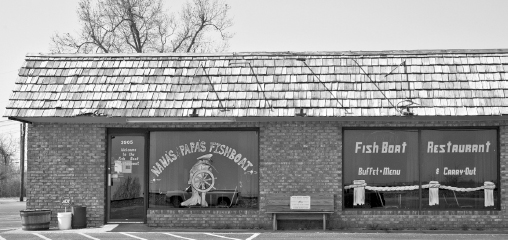
The Fish Boat was started back in 1976 and is today run by Don and Kathy Stiles. It’s known for not just catfish but also ribs, crab cakes and a famed strawberry cake. Grav Weldon.
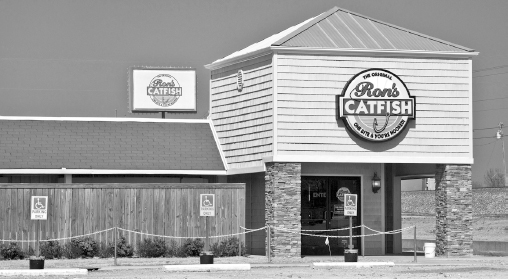
Ron’s Catfish, on the west side of Jonesboro past where Gee Street runs into Dan Avenue, is best known for its oversized buffet, which features catfish, hush puppies, crawfish, frog legs, shrimp, chicken and a dizzying array of desserts single-serve—including carrot and red velvet cakes, coconut and chocolate meringue pies, pecan pie, sweet potato pie, brownies and ice cream. Grav Weldon.
Presley’s has served Jonesboro for more than forty years, and if Stallings can keep ahold of it, it could go another forty.
Next time I go, I hope they have the brown derby again. I think, if it’s summer, I’ll sit outside on a curb stop and remember the traffic that used to pass on Gee Street.
SUE’S KITCHEN, JONESBORO
Sue’s Kitchen closed in 1994, a year before I came to the city the first time. Situated in the Church Street Station building, it was the dominion of Sue Robinson Williams, who had been catering in the area since 1967. Williams started the restaurant in 1985 and had stayed with it for nearly a decade before turning back to catering with Expressly Sue’s Catering. She and her son John ran that business until 2005. He took a few restaurant management jobs in the interim, but in August 2010, John Williams decided to reopen the restaurant in his mother’s name in a downtown building that has served as a post office, a courthouse annex and a jail over its lifespan. The cavernous main floor of the building is mostly open, with dainty tables and large windows. The menu is very much teahouse meets burger joint, with a nice selection of sandwiches, specials and salads. And on Saturday, there’s a brunch.
Hollywood horror movie star Vincent Price once begged for the recipe for Sue’s famed peanut butter pie. Her decadently pink lemonade pie has become a recent fan favorite.
FRONT PAGE CAFÉ, JONESBORO
I’m not a big fan of having rolls thrown at my head. But some folks are, which is why restaurants such as Lambert’s Café in Sikeston, Missouri, became so popular. Jonesboro has its own version in the Front Page Café. I used to love sitting in the old location on Caraway over by Barnhill’s and passing around veggies family style to the folks at my table. I knew to make an agreement with the waitstaff early on—tips were contingent on me not getting crumbs in my hair from thrown rolls. Yes, that actually happened. Once.
Mike Felts opened the original restaurant along Caraway Road back in 1984 in the old Fat City Grill location. It was moved out to the bypass in 2001. The restaurant burned in 2008, but eight months later it once again opened. Current owner Mickey Felts (Mike’s brother) made sure the restoration was complete, even the newspaper pages and sports memorabilia that line the walls were salvaged. He’s also taken the opportunity to brighten up the menu with more items.
Still, there are pass-arounds like fried okra, beans, carrots and corn at lunch and dinner. And fortunately for those who haven’t had their coffee, the biscuits are delivered on a plate at breakfast, rather than by air.
LAZZARI ITALIAN OVEN, JONESBORO
The fact that my favorite restaurant in Jonesboro is Lazzari Italian Oven is no secret. It’s the first one I ever dined at there. I stopped in at Lazzari Italian Oven after what I thought was my disastrous “I’m sorry, I know nothing about TV” job interview at KAIT in September 1995. I commiserated with my boyfriend over a Mista salad and a plate of pasta, and by the time we got to the tiramisu I had resigned myself to not getting the job.
Well, that was something. I did get the job after all and spent most of the next three years working as a television producer and getting to know the Upper Delta.
Lazzari Italian Oven opened up in 1994, a new venture from the folks that ran the Galley, a popular local fish restaurant. In fact, Lazzari is Italian for “galley,” a fact I didn’t know until I started researching this book. The eatery moved into a former Western Sizzlin’ on South Caraway Road. It’s not too fancy, but it is nicely decorated. Waiters come to the table and write their name on the white butcher paper overlay with crayons (being able to sign one’s name upside down seems to be a condition of employment), light a candle and bring the best Italianesque bread in the world with olive oil, pepper and whipped butter.
Those sesame-encrusted salty top loaves are addictive, and they don’t stop coming until you’re done. The Mista salad—a sweet, soaked salad with pepperoncinis, tomatoes, olives, artichoke hearts, onions and lettuce with cheese—is equally habit-forming. And Lazzari’s asiago cream sauce paired with sundried tomatoes in a number of dishes, such as the cannelloni and the beef ravioli, is stupendous.
Now, some great place where you can still have a great salad, entrée and dessert for two people for twenty dollars should be able to tough it out with no problem, right? When Olive Garden opened across town with its private license and reputation for endless salad, there was some concern that it would chase Lazzari out of town. Nope. The restaurant’s homemade sauces and reasonable prices have kept it afloat. And if you really want wine with your meal, you can bring it in yourself.
TRUMANN
Southeast of Jonesboro, U.S. Highway 63 runs as an expressway unimpeded through its meeting with Interstate 55, south of Turrell. There’s been word for years that the stretch will be renamed Interstate 555, but even though signs are in place, we probably won’t see that happen in my lifetime. See, one of the rules of being an interstate is that you can’t have farmers crossing those lanes getting from one field to another. So it’s either build overpasses and underpasses for tractors to traverse those roadways, or not be an interstate.
Past the last Jonesboro exit, the highway quickly falls into a long flat plain of farmland that stretches out in every direction. In the fall, travel can be treacherous as farmers burn off fallow fields (a practice that may soon be eliminated).
Trumann started off as a lumber camp along the Frisco rail line. Back then, the area’s position in the sunken lands (a region that includes part of Poinsett, Green and Craighead Counties to the east of Crowley’s Ridge that sank during the New Madrid Earthquake in 1811) encouraged forest growth, and the heavily wooded areas were perfect for harvest. The town of Mosher was established in 1896, only to have its name changed to Weona in 1902 (there’s a town named Weona about fifteen miles away today) and then to Trumann in 1904, which was named, you guessed it, after a railroad executive, in this case one from New York who never visited.
The craziest thing that ever happened in Trumann occurred during World War I. At the time, communities all across the country were being encouraged to out-patriot each other by fundraising with Liberty Loan drives. Residents got so caught up in the fervor that those who didn’t contribute (or didn’t give enough) were shamed. One day during a particularly enthusiastic rally, town fathers publicly whipped two men who refused to support the drive. The crowd surged through the streets, and a local merchant was pulled from his store by ladies and whipped while his store was painted yellow. Egged on by adrenaline, the “loose women” of Trumann were rounded up and thrown in the slough. They were hauled out by the proper ladies of the community, lashed and put on a train out of town.
Trumann flourished in the twentieth century as a Singer town; all that timber made good wood for making sewing machine cabinets. Industry still finds a home there, as do many Jonesboro workers who seek the amenities of a small town.
There are several great places to eat in Trumann, including the earlier mentioned Couch’s Log Cabin Bar-B-Q. Another barbecue joint, Al’s Barbecue, lies along Arkansas Highway 463 in town. The restaurant dates back to 1969, and it could just as easily be called Norma’s. The grandmotherly figure who greets you when you walk in the door is Norma, and she expertly calls every order to the kitchen, just as she’s done for more than three decades.
The barbecue at Al’s is okay, but what the place is known for are hand-pulled chicken tenders and a proprietary ranch dressing that’s made at the store. Locals know the best bargain is to order the buffet so they can enjoy as many of those marvelous hand-battered strips as they’d like.
Next door to Al’s, you’ll find Hightower Tastee Freeze, a classic dairy diner known for great burgers and fries that’s been around since 1980.
Jerry’s Steakhouse opened in 1981, and I’m going to be honest with you, it’s a real dive. But it has the best steak in all of northeast Arkansas. Jerry Pillow took a Sears backyard grill, fitted it into a fireplace and created an altar to flame-broiling behind a bar in a one-room saloon. It didn’t take long for word to get out about the fantastic grilled steaks and burgers he could conjure from his makeshift apparatus. A legend was born.
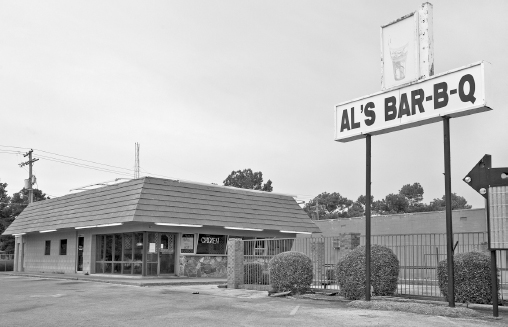
Al’s Barbecue in Trumann. Grav Weldon.
Jerry retired in 2000, and his son Tracy and daughter-in-law Kellie took over. They added sandwiches, including the Jerry’s Signature Steak Sandwich, and put in a large commercial grill. Three years later, they bought the place next door and opened up a wall for more dining.
Any Arkansas State University student on a budget will tell you the best way to treat the person you’re trying to woo is to take them to Jerry’s on a Thursday night for the Sweetheart Special. That’s a large ribeye and a small ribeye with potatoes and salad for about thirty dollars (the same deal with sirloin is twenty-one dollars). Flame-kissed steaks will keep Jerry’s going for years to come.
MARKED TREE
The Southern Tenant Farmers Museum enhances knowledge and understanding of tenant farming and agricultural labor movements in the Mississippi River Delta. It opened in 2006 in the historic Mitchell-East Building in Tyronza. During the 1930s, the building housed the dry cleaning business of H.L. Mitchell and the service station of Clay East, two of the organizers of the Southern Tenant Farmers Union. It served as the unofficial headquarters for the union from 1934 until its offices were moved to Memphis for safety a year and a half later. Learn more at stfm.astate.edu.
Farther down U.S. Highway 63 sits Marked Tree, which itself sits between the Saint Francis and Little Rivers. That may not be unusual, but this is: the rivers run different directions. Marked Tree is named for an old oak tree on the Little River that used to have a big M on it.
After World War II, a new fad quickly caught on everywhere across the United States—a run of little restaurants little more than quick-serve kitchens that operated out of windows and served items such as burgers, ice cream and fries. These drive-ins became popular, not just because of the lack of a need for waitstaff or someone to clean a dining room but also for their quick preparation of food items. They also spread quickly thanks to the car culture that followed the war, as an era of prosperity allowed more Americans to own their own vehicles. Dining in said vehicle became a novelty, and the drive-in catered to that aesthetic.
Walker’s Dairy Freeze actually started out in 1951, serving up burgers and specialty drinks such as the Purple Cow to a community that fell in love with the place. Its current owner, Evelyn Walker, purchased the restaurant in 1981 and has changed little about it. In fact, the original sign sits out front—completely unreadable.
Evelyn still works at the little stand, with its two windows and a drive-thru, making hand-dipped shakes and brown derbies. She prides herself on a menu where even the pickiest eater will find something to eat. Alongside burgers and fries and tots, you’ll find fried chicken gizzards, fried shrimp, catfish, onion rings, barbecue sandwiches and what’s considered the best pizza burger in the area.
A pizza burger is similar to a steak sandwich but includes marinara and mozzarella in its below-the-crust construction. Traditionally served on a bun with Miracle Whip (instead of mayo) and lettuce, it’s a longtime favorite for drive-in lovers across the Delta.
DYESS COLONY AND JOHNNY CASH
A Painted House, a novel written by attorney-turned-author John Grisham, is celebrated at a home in Lepanto constructed for the Hallmark Hall of Fame movie of the same name. Tours are available upon request. More information is available at LepantoAR.com.
These lands between Marked Tree, Tyronza and the Mississippi River have had their share of good and bad. They were also home to one of the greatest singers in American music.
J.R. Cash was born in a little town called Kingsland in Arkansas’s Timberland Region. He was three years old when his parents, Ray and Carrie Cash, moved to Dyess as part of the Dyess Colony Resettlement Area in 1935. The young boy grew up, went to church there and even suffered his first loss when his beloved brother Jack died following a sawmill accident in 1944.
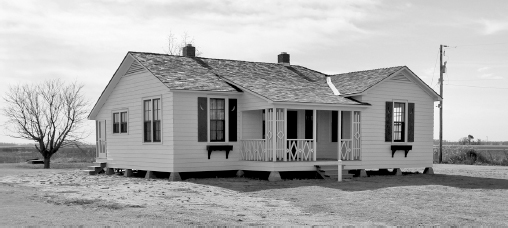
The boyhood home of Johnny Cash at the historic Dyess colony. Kat Robinson.
Cash took the name Johnny when he went into the air force in 1950. He would later tell audiences how many of his songs were influenced by his time at home, including “Five Feet High and Rising.” He would go on to be inducted into the Country Music, Rock ’N’ Roll and Gospel Music Halls of Fame.
In August 2014, Historic Dyess Colony: Boyhood Home of Johnny Cash was opened. The attraction includes both the restored home itself and the old Dyess Administration Building, which records the history of the colony and holds many old Cash family items, including Johnny Cash’s air force uniform and Boy Scout book. Learn more at dyesscash.astate.edu.









